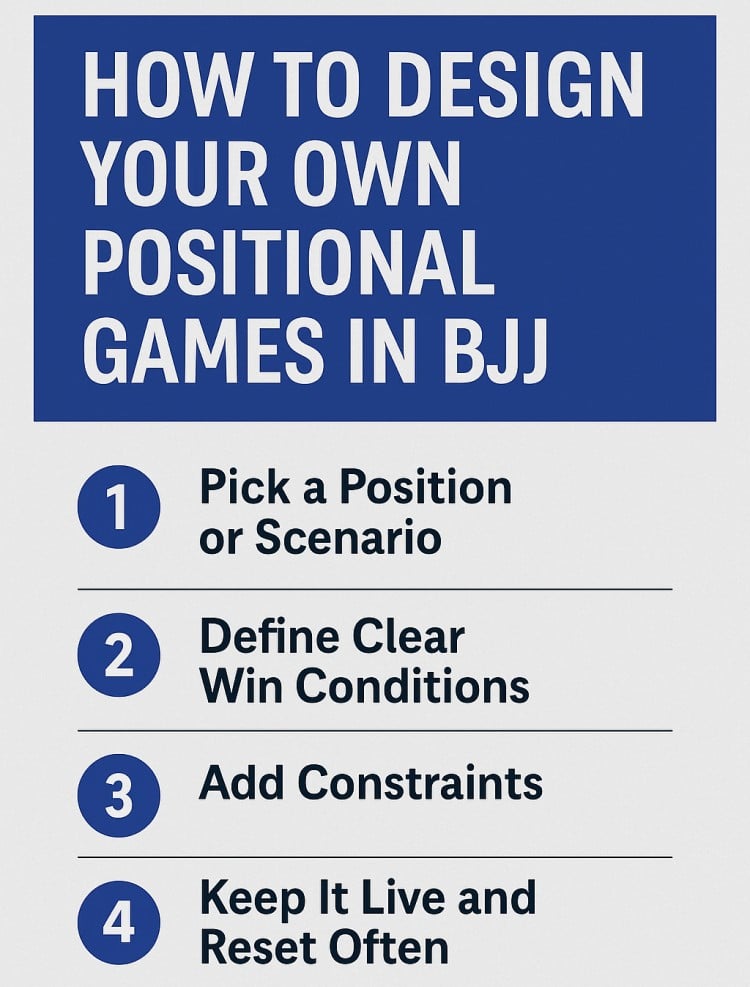Positional sparring has long been a staple in Brazilian Jiu-Jitsu training — a way to isolate and refine specific parts of your game. But if you want to make your training even more effective, fun, and tailored to your needs, learning how to design your positional games using ecological principles is a powerful tool.
Creating structured, constraint-led environments enables you to improve more quickly, think more critically, and develop adaptable skills, rather than just memorizing moves.
In the previous article, we learned why the ecological approach works. This article will explain the key principles of designing your games and give you actionable examples you can use today.
What Are Positional Games?
A positional game is a focused training drill in which partners operate within a specific position or scenario, often with clearly defined goals and limitations. These games allow you to train in a live but limited environment where skill acquisition can happen faster.
Unlike traditional drilling or rolling:
- You’re not repeating steps.
- You’re not starting from neutral.
- You’re training for depth and decision-making within a slice of jiu-jitsu
Why Design Your Own Games?
Designing your games allows you to:
- Target your weak spots with intention
- Improve skills through real-time problem-solving
- Make training more engaging and purposeful
- Develop your style, not just copy others
Whether you’re a hobbyist, competitor, or coach, this lets you take control of your development. To get a deeper understanding, read our article: The science behind learning faster through play.
How to Design a BJJ Positional Game

1. Pick a Position or Scenario
Select a situation that you would like to develop. Examples include:
- Guard retention against a knee slice
- Mount escapes
- Back control maintenance
- Standing grip fights
Keep it specific and relevant to your current goals.
2. Define Clear Win Conditions
Both players need goals to give the game direction. For example:
Mount Escape Game
- Bottom wins by regaining guard or getting to half guard
- Top wins by maintaining mount for 20 seconds or submitting
This encourages urgency and problem-solving.
3. Add Constraints
Constraints are limits that shape behavior. Use them to:
- Remove tools (e.g., “pass without grips”)
- Add urgency (e.g., “score in 30 seconds”)
- Emphasize habits (e.g., “no submissions, only control”)
Constraints force you to adapt and develop better movement options.
4. Keep It Live and Reset Often
Games should be played at realistic intensity with resistance. After each exchange:
- Reset quickly
- Switch roles (or partners)
- Reflect and repeat
You want many decision-making reps in a short period.
5. Modify As You Go
The beauty of designing games lies in their flexibility. If something feels too easy, too chaotic, or too slow:
- Change the rules
- Add or remove space
- Swap grips, timers, or movement limitations
You’re in control. Let your creativity guide learning.
Sample Positional Game: Turtle vs. Back Take
- Start with one player in turtle, other behind (hands on hips)
- Attacker wins by taking the back or rolling them to side control
- Defender wins by escaping to guard or standing
- Constraint: attacker can’t jump hooks in immediately
This develops balance, hand fighting, and awareness — without needing to “learn” a technique first.
Final Tips for Better Games
- Start simple, then add complexity
- Use a timer (1–3 minutes per round)
- Film and review key moments for insight
- Pair up with someone at a similar level for balanced learning
Final Thoughts
Designing your positional games makes your jiu-jitsu more intentional, dynamic, and personal. Instead of just following a curriculum, you create learning environments that evolve with your game, helping you grow faster.
So next time you hit the mats, don’t just roll or drill. Set up a game, add constraints, and train like a problem-solver.
For a quick start, check out five ecological games to start with.
More in the Ecological Approach
- The Ecological Approach to Learning BJJ
How to learn using this method. - Why BJJ Isn’t About Memorizing Techniques
How the brain works and why this approach can be an effective learning method.




